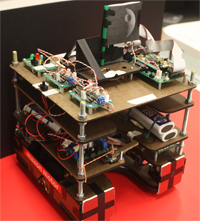The Death Star is a fully-autonomous robot capable of playing a simplified version of the game Capture the Flag as defined in the ME 218B Winter 2009 Project Specification and described below. The robot, which fits within a 12-inch cube, is designed mechanically to be able to hold two flags within its perimeter, using a passive, one-way mechanical stop to contain the flags once they have been collected. The Death Star is capable of playing as either the red or the green team, and has dedicated software for sudden death in the event of a tie game. It is entirely battery powered, and thus requires no tether of any kind on the playing field.
The game is played on an 8’ x 8’ flat surface, upon which the robot drives. In actual game play, two robots play on the field at the same time, competing against each other. The north and south ends of the field (8’ x 1.5’ each) are the home regions for the opposing robots. These regions consist of an 8’ x 0.5’ strip of white (regular play zone), an 8’ x 0.5’ strip of green (goal zone), and an 8’ by 0.5’ strip of black (dead zone). These home regions are separated from the remaining 8’ x 5’ area by thin strips of green tape. The remaining 8’ x 5’ is all white (regular play zone), with the exception of three thin black lines going north-south that break up the main playing area into four 2’ x 5’ rectangles.
Each robot is assigned to a team (red or green), and thus to a particular side of the field (south and north, respectively.) The two corners at the south (red) end of the field have 12” tall beacons emitting infra-red light at 1.25 kHz with a 30% duty cycle; the two corners at the north (green) end of the field have 12” tall beacons emitting infra-red light at 1.25 kHz with a 70% duty cycle. The red robot starts in the southeast corner of the field, at a random orientation; the green robot starts in the northwest corner of the field, at symmetrically the same random orientation. Each “flag” is a 9” tall beacon that emits infra-red light at 1.25 kHz with a 50% duty cycle. When a flag is lifted off the ground or placed in a dead zone, it stops emitting light; when a flag is placed in a goal zone, it emits light more brightly than when it is placed in a regular play zone. The initial placement of the five flags is symmetric with respect to north and south; the exact initial location of each flag can be found in the ME 218B Winter 2009 Project Specification.
Each game is started by a bright camera flash; the robots are not allowed to move until this flash goes off. The robots then have two minutes to collect as many flags as possible and deposit them in their goal zone. There are no particular restrictions here; robots can collect flags from the field or the opponent’s goal zone; robots can bring flags to their goal and leave to get more, or collect multiple flags at the same time and hold on to them for the duration of the game. At the end of two minutes, both robots must cease all motion, and the robot with the most flags in its goal zone wins the round. In the event of a tie, a sudden death match is played. The sudden death match has the same initial conditions, but rather than working with a two-minute time limit, the first robot to get a single flag into its goal wins.
Fundamentally, The Death Star’s strategy is to drive up to a flag, maintaining the proper orientation to the flag using a set of three infra-red sensors placed at the same level as the flag’s emitters. Once the robot identifies that the flag has been captured in one of its two flag cavities (via the use of a bump sensor), the robot turns around and repeats this procedure for a second flag on the other side, using a symmetric set of IR sensors. (When no flag has been captured, the robot is flexible enough to use whichever cavity is closer to a flag first; once the first flag has been captured, the robot only searches for flags on the side that still has an empty cavity available.) Once two flags have been captured, the robot uses a suite of five tape sensors to find a black line on the playing field and follow it back to the home goal area (a fourth IR sensor on each side of the robot is used to verify that the line is being followed in the proper direction.) These tape sensors are also used to effect a 90-degree rotation within the goal region, to allow both captured flags to rest in the goal without ever leaving the possession of the robot. Thus, The Death Star is designed to only capture two of the five flags on the field, and rely on the fact that the opponent robot will not be able to capture all three remaining flags to win the game. This strategy got The Death Star to a Final Four appearance in the single-elimination tournament of twelve teams, where it was in fact defeated by a robot that could capture three flags in two minutes.
The Death Star is the creation of Andrew Parra, Anup Shah, and David Hoffert, all graduate students at Stanford University in Palo Alto, California, for the project portion of the course ME 218B, Winter 2009.


